
The Komondor, also known as the Hungarian sheepdog, is a large, white-coloured Hungarian breed of livestock guardian dog with a long, corded coat.

A sheep dog or sheepdog is generally a dog or breed of dogs historically used in connection with the raising of sheep. These include livestock guardian dogs used to guard sheep and other livestock and herding dogs used to move, manage and control sheep and other livestock.

A herding dog, also known as a stock dog or working dog, is a type of dog that either has been trained in herding livestock or belongs to one of the breeds that were developed for herding. A dog specifically trained to herd sheep is known as a sheep dog or shepherd dog.

Collies form a distinctive type of herding dogs, including many related landraces and standardized breeds. The type originated in Scotland and Northern England. Collies are medium-sized, fairly lightly-built dogs, with pointed snouts. Many types have a distinctive white color over the shoulders. Collies are very active and agile, and most types of collies have a very strong herding instinct. Collie breeds have spread through many parts of the world, and have diversified into many varieties, sometimes mixed with other dog types.
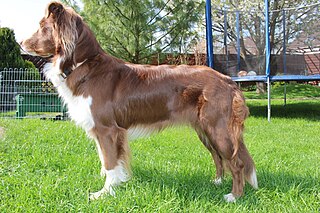
The Australian Shepherd is a breed of herding dog from the United States. The name of the breed is technically a misnomer, as it was developed in California in the 19th century. It is believed to have its origins in sheepdog breeds from northwest Spain, as well as collies imported, alongside sheep, from Australia and New Zealand; the breed reportedly took its name from this trade. Originally used solely as a herding dog, the Australian Shepherd has become one of the most popular companion dog breeds in North America.

The Cardigan Welsh corgi is one of two different varieties of livestock-herding dog breeds known as Welsh corgis, with the other being the Pembroke Welsh corgi. It is one of the oldest breeds of the British Isles. Cardigan Welsh corgis are known to be an extremely loyal and trainable dog breed, naturally attuned to herding many different animals, from poultry and waterfowl to large livestock such as sheep and cattle. They are also versatile and can live in a variety of settings.

The Smooth Collie is a breed of dog developed originally for herding. It is a short-coated version of the Rough Collie of Lassie fame. Some breed organisations consider the smooth-coat and rough-coat dogs to be variations of the same breed.

The Rough Collie is a long-coated dog breed of medium to large size that, in its original form, was a type of collie used and bred for herding sheep in Scotland. More recent breeding has focused on the Collie as a show dog, and also companion. The breed specifications call for a distinctive long narrow tapered snout and tipped (semiprick) ears, so some dogs have their ears taped when young. Rough Collies generally come in shades of sable and white, blue merle, tri-coloured, and colour-headed white.

The Catalan Sheepdog is a breed of Catalan Pyrenean dog used as a sheepdog. This dog is bred in Europe, especially in Spain, Finland, Germany, and Sweden.

The Old English Sheepdog is a large breed of dog that emerged in England from early types of herding dog. Obsolete names for the breed include Shepherd's Dog and bob-tailed sheep-dog. The nickname Bob-tail originates from how dogs of the breed traditionally had their tails docked. Old English Sheepdogs can grow very long coats with fur covering the face and eyes and do not shed unless brushed.

The Tornjak, also known as the Bosnian-Herzegovinian sheepdog, is a recreated breed of livestock guardian dog native to Bosnia and Herzegovina and Croatia. They are molosser-type mountain dogs, similar to other livestock guardian breeds of the region, the Šarplaninac, Bucovina Shepherd Dog, and the Greek Shepherd.
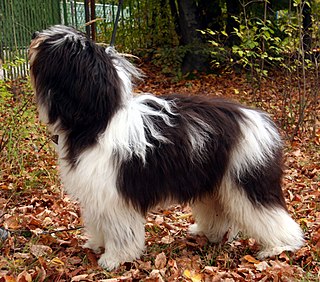
The Polish Lowland Sheepdog, is a medium-sized, shaggy-coated, sheep dog breed native to Poland.

The Welsh Sheepdog is a breed of herding dog of medium size from Wales.

The Himalayan Sheepdog, known locally by various names including the Bhote, Bangara or Gaddi Kutta, and sometimes called the Himalayan Mastiff, is a breed of livestock guardian dog from the Himalayas. The Himalayan Sheepdog is found in the Himalayan foothills from eastern Nepal to Kashmir. The breed is primarily used as a livestock guardian dog, protecting flocks of yak and sheep from various predators, and as a property guardian dog; unusually for a livestock guardian, the breed is also used to assist with herding. The Himalayan Sheepdog is also used to assist in hunting.
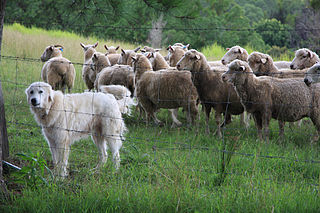
A livestock guardian dog (LGD) is a dog type bred for the purpose of protecting livestock from predators.
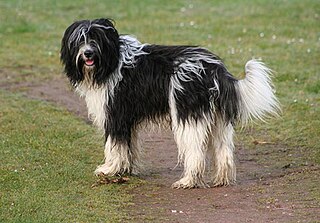
The Schapendoes or Dutch Sheepdog, is a breed of dog originating in the Netherlands. The Schapendoes was originally a herding dog and general farm dog, but today also participates in dog sports such as agility and flyball.

The Carea Leonés is a breed of herding dog from León, Castile and León, Spain (Europe), and is used as a sheepdog. For centuries, they tended flocks of Churra (sheep) in the mountains of the historical region of León.
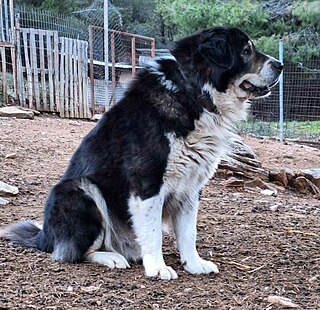
The Greek Shepherd or Greek Sheepdog is a breed of livestock guardian dog from Greece. Thought to be ancient in origin, the Greek Shepherd is very closely related to livestock guardian dog breeds from neighbouring countries; it is believed that some dogs are simultaneously claimed to be other breeds as they migrate annually across national borders with the flocks they protect in search seasonal pastures.

The Cão de Gado Transmontano or Transmontano Mastiff is a breed of livestock guardian dog from Portugal. It originates in the historical province of Trás-os-Montes e Alto Douro in north-eastern Portugal, and is a rare breed confined mostly to this area.

The Pumi is a medium-small breed of sheep dog from Hungary. They are capable herding dogs, able to gather and work close to farm stock, particularly sheep, to keep them under control. Pumik have an extended, tapered muzzle with prominent ears, and a tail curled over their back, and are sometimes described as having a whimsical expression. The double coat has a mix of wavy and curly hair.



























